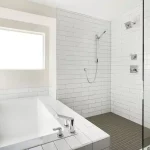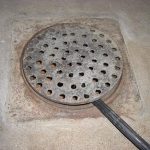When constructing a new bathroom, it’s important to consider all the necessary components to ensure a healthy and functional space. One component that should not be overlooked is the shower drain vent.
Without proper ventilation, molds can begin to grow in the walls, creating an unhealthy environment in your home. Additionally, without a vent pipe, shower water may not drain properly, leading to waterlogging.
In this article, you’ll learn why it’s crucial to install a vent for your shower drain. We’ll delve into the details of venting a shower drain and provide you with all the information you need to make an informed decision about your bathroom construction.
Why Does A Shower Drain Need A Vent? 5 Practical Reasons
If you are wondering why your shower drain needs a vent, here are five practical reasons to consider:
1. Prevent Molds In the Wall
Without a proper ventilation system, gases produced by the dirt and chemicals in the drainage system can remain in the walls of the bathroom. This can lead to the growth of molds within the walls, which can ultimately require rebuilding the walls if left unchecked. By ensuring proper ventilation for the shower drain, you can prevent the growth of molds and keep your bathroom healthy and clean.
2. Prevents Diseases
Molds are not only unsightly, but they can also be dangerous for those with allergies or asthma. Without a vent for the shower drain, molds can form in the walls of the bathroom, making the whole house unhealthy. By ensuring proper ventilation, you can keep your family members healthy and away from unwanted diseases.
3. Prevents Water-Logging
Air and gas can hinder the flow of water in the shower drain if there is no vent attached to it. This can lead to water-logging and even overflowing of the shower drain. By attaching a vent to the shower drain, you can ensure that the drainage system works smoothly and prevent any potential water damage.
4. Increases The Life Of The Pipes
Without proper ventilation, drain pipes can become rusty and need to be replaced much earlier than expected. This is because the air and gas can create a chemical reaction on the surface of the drain pipe. By attaching a vent to the shower drain, you can prevent this chemical reaction and ensure that the drain pipes last longer, saving you money in the long run.
5. It’s a Legal Issue
In most states of the USA, it is illegal to not connect a vent to a shower drain. Failure to comply with this regulation can result in penalties. This is because having proper ventilation for the shower drain is not only important for your health, but also for the safety of your home.
By ensuring that your shower drain has a vent, you can prevent molds, diseases, water-logging, premature pipe replacement, and legal issues. So, make sure to connect a vent to your shower drain to keep your bathroom healthy, safe, and functional.
3 Tips For Connecting The Shower Drain With A Vent:
Mind The Size Of The Vent
When installing a shower drain, it is important to consider the size of the vent pipe. For a 2-inch shower drain pipe, it is recommended that you use a vent pipe that is at least 1½ inches wide.
However, if you want to be extra cautious, you can use a vent pipe that is 2 inches wide for a 2-inch drain pipe. This will ensure proper ventilation and prevent any clogs or backups.
Know Local Building Code
Before installing a shower drain, it is important to be familiar with your local building codes. Local municipalities often have specific directives for the installation of vents for plumbing fixtures, including shower drains.
Make sure to check your local building code to ensure that your shower drain is up to code and that you have obtained any necessary permits.
Maintain The Distance
When installing a vent for your shower drain, it is important to measure the distance between the shower trap arm and the vent carefully.
The maximum distance between the two should be no more than 5 feet in most cases, although some municipalities may allow up to 8 feet.
Any vent that is more than 8 feet away from the shower trap arm is considered useless and will not provide proper ventilation.
Be sure to follow local codes and regulations regarding the distance between the shower trap arm and the vent.
Commonly Asked Questions:
What Happens If You Don’t Vent a Shower Drain?
If you do not vent a shower drain, it can lead to waterlogging and mold growth within the bathroom walls. This can be a health hazard for your family. Additionally, the drain pipes will wear out sooner than expected, leading to increased maintenance costs.
How to Vent a Shower Drain?
There are two ways to vent a shower drain.
Firstly, you can tie the vent with the main stack of the bathroom by cutting a tee into the stack. The tee should be 3 inches x 1½ inches in size.
Secondly, you can attach the vent with an existing tee if you are replacing a shower with a new one.
In this case, you have to use a coupling to connect the vent with the shower drain. You will need to cut the wall open at the point where the tee is located.
Can You Use a Plumbing Cheater Vent with the Shower Drain?
A cheater vent is an alternative to typical venting systems that allows air or drainage to exit the house without using any pipe. If you are installing a new shower vent to an existing shower, using a cheater vent can minimize construction costs.
However, if you are constructing the whole bathroom from scratch, using a cheater vent will increase construction costs.
Must a Shower Vent Go Through the Roof?
Plumbers often get the vents through the roof, but there is no hard and fast rule about it. The shower vent does not need to go through the roof. You can get your shower vent out of your house through the walls. The general rule is that the vent should run higher than the highest window of the house.
Final Words
In conclusion, connecting your shower drain with a vent pipe is mandatory. Not only will it minimize your bathroom maintenance cost, but it will also ensure a healthy environment for your home. In fact, it may be against the law to not have a venting system in your shower drain.




